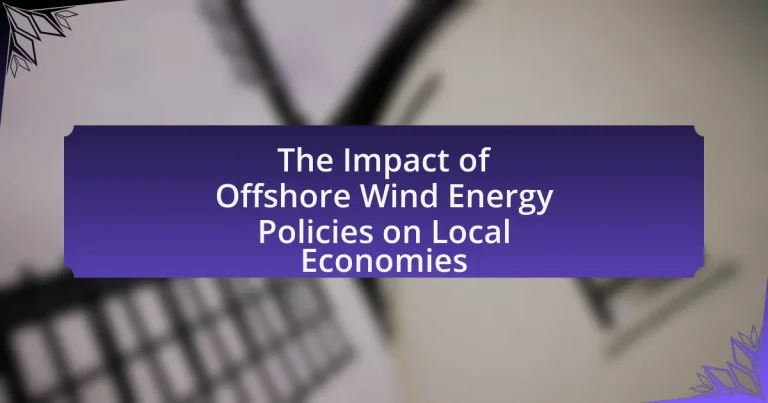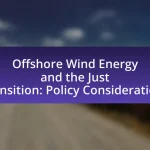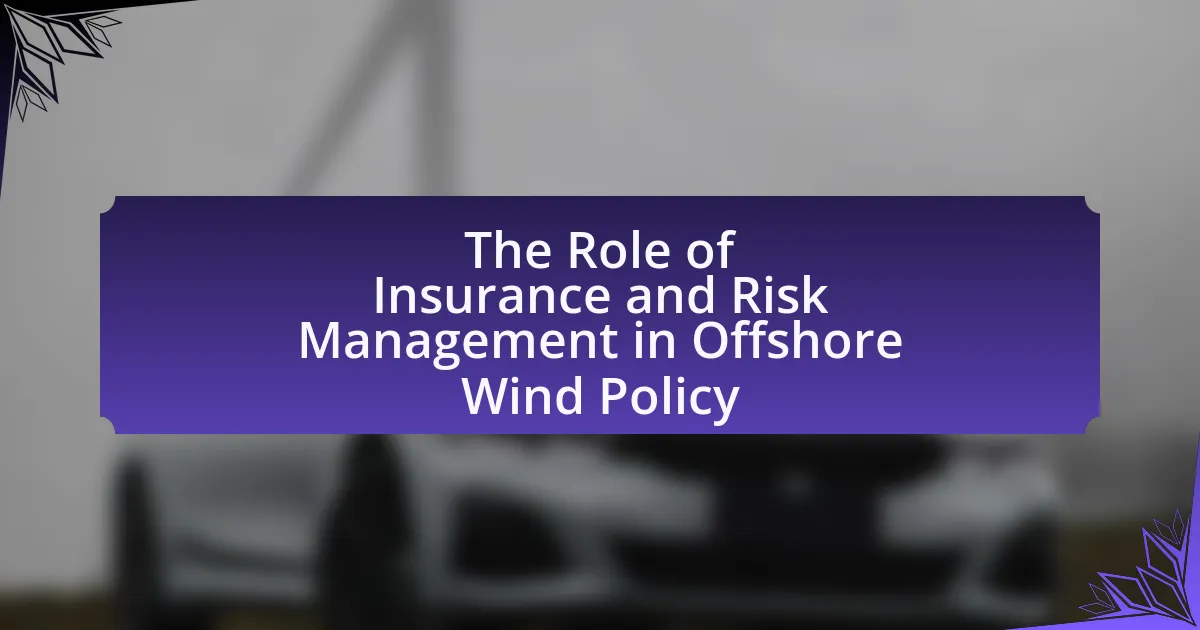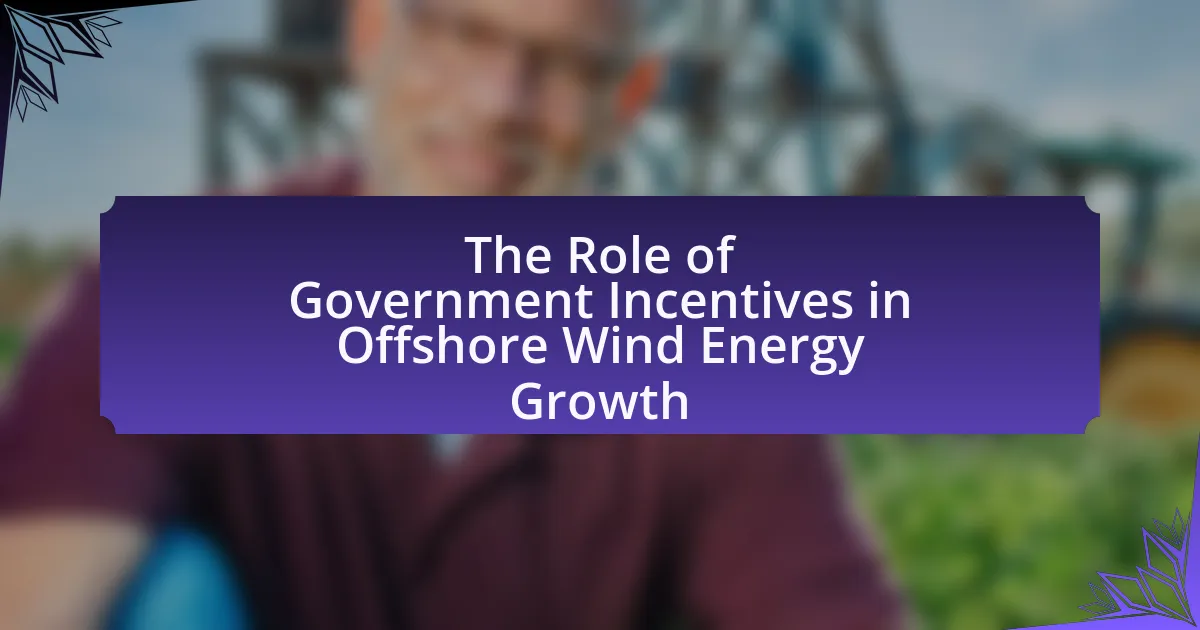Offshore wind energy policies are regulatory frameworks established by governments to facilitate the development and operation of offshore wind farms, incorporating financial incentives and environmental assessments. These policies significantly impact local economies by creating jobs, attracting investments, and enhancing local industries, with projections indicating that the offshore wind sector could support over 77,000 jobs in the United States by 2030. Key components of these policies include regulatory frameworks, financial incentives, and stakeholder engagement, which vary across regions, influencing economic growth and job creation. Challenges such as regulatory hurdles and environmental concerns can impede policy effectiveness, but successful initiatives demonstrate the importance of community involvement and collaboration between local governments and industry stakeholders.
What are Offshore Wind Energy Policies?
Offshore wind energy policies are regulatory frameworks and guidelines established by governments to promote the development, installation, and operation of offshore wind farms. These policies typically include incentives such as tax credits, grants, and subsidies to encourage investment in offshore wind projects, as well as environmental assessments and permitting processes to ensure sustainable development. For example, the United States has implemented policies like the Investment Tax Credit (ITC) and the Offshore Wind Investment Act to stimulate growth in the offshore wind sector, aiming to achieve a target of 30 gigawatts of offshore wind capacity by 2030.
How do Offshore Wind Energy Policies influence local economies?
Offshore wind energy policies significantly influence local economies by creating jobs, attracting investments, and stimulating local industries. For instance, the deployment of offshore wind farms requires a skilled workforce for construction, operation, and maintenance, leading to job creation in coastal communities. According to a report by the U.S. Department of Energy, the offshore wind sector could support over 77,000 jobs by 2030 in the United States alone. Additionally, these policies often encourage local supply chains, as components for wind turbines are sourced from nearby manufacturers, further boosting local economic activity. Furthermore, the investment in offshore wind projects can lead to increased tax revenues for local governments, which can be reinvested into community services and infrastructure.
What are the key components of Offshore Wind Energy Policies?
The key components of Offshore Wind Energy Policies include regulatory frameworks, financial incentives, environmental assessments, and stakeholder engagement. Regulatory frameworks establish the legal and procedural guidelines for offshore wind development, ensuring compliance with national and local laws. Financial incentives, such as subsidies and tax credits, encourage investment in offshore wind projects, making them economically viable. Environmental assessments evaluate the potential impacts of wind farms on marine ecosystems and local communities, ensuring sustainable development. Stakeholder engagement involves collaboration with local communities, industry stakeholders, and governmental bodies to address concerns and foster support for offshore wind initiatives. These components collectively facilitate the growth of offshore wind energy while balancing economic, environmental, and social considerations.
How do these policies vary across different regions?
Offshore wind energy policies vary significantly across different regions due to factors such as regulatory frameworks, economic incentives, and environmental considerations. For instance, in Europe, countries like Denmark and Germany have established comprehensive support mechanisms, including feed-in tariffs and auctions, which have led to substantial investments and rapid deployment of offshore wind farms. In contrast, the United States has seen a more fragmented approach, with states like Massachusetts and New York implementing aggressive targets and incentives, while others lag behind due to regulatory hurdles and lack of cohesive policy. This disparity in policy frameworks directly influences local economies, as regions with supportive policies tend to experience greater job creation and economic growth associated with offshore wind energy development.
Why are Offshore Wind Energy Policies important for economic development?
Offshore wind energy policies are crucial for economic development because they stimulate job creation, attract investments, and promote technological innovation. These policies facilitate the establishment of offshore wind farms, which require a skilled workforce for construction, operation, and maintenance, thereby generating thousands of jobs. For instance, a report by the U.S. Department of Energy indicates that the offshore wind sector could create over 77,000 jobs by 2030. Additionally, these policies encourage private sector investments, with the global offshore wind market projected to reach $1 trillion by 2040, enhancing local economies through increased tax revenues and infrastructure development. Furthermore, the promotion of renewable energy technologies fosters innovation, positioning regions as leaders in the green energy transition and attracting further economic opportunities.
What economic benefits do these policies provide to local communities?
Offshore wind energy policies provide significant economic benefits to local communities by creating jobs, stimulating local investment, and increasing tax revenues. These policies lead to the establishment of new wind farms, which require a skilled workforce for construction and maintenance, resulting in thousands of job opportunities. For instance, a report by the U.S. Department of Energy indicates that the offshore wind sector could support over 77,000 jobs by 2030. Additionally, local businesses benefit from increased demand for services and materials, fostering economic growth. Furthermore, the taxes generated from these projects contribute to local government funding, enhancing public services and infrastructure.
How do Offshore Wind Energy Policies impact job creation?
Offshore wind energy policies significantly enhance job creation by fostering investment in renewable energy infrastructure and technology. These policies often include incentives such as tax credits, grants, and regulatory support, which stimulate the development of offshore wind farms. For instance, a report by the U.S. Department of Energy indicates that the offshore wind sector could create over 77,000 jobs by 2030, driven by policy frameworks that encourage project development and supply chain growth. Additionally, regions with established offshore wind policies have seen a surge in local employment opportunities in manufacturing, installation, and maintenance, further validating the positive correlation between supportive policies and job creation in the renewable energy sector.
What challenges do Offshore Wind Energy Policies face?
Offshore wind energy policies face challenges such as regulatory hurdles, high initial investment costs, and environmental concerns. Regulatory hurdles include complex permitting processes that can delay project implementation, as seen in the United States where the Bureau of Ocean Energy Management oversees leasing and permitting, often resulting in lengthy timelines. High initial investment costs are significant, with estimates indicating that offshore wind projects can require upwards of $4 million per megawatt of installed capacity, making financing a critical issue. Environmental concerns arise from potential impacts on marine ecosystems and local wildlife, leading to opposition from environmental groups and necessitating extensive environmental assessments. These challenges collectively hinder the growth and effectiveness of offshore wind energy policies.
How do regulatory hurdles affect the implementation of Offshore Wind Energy Policies?
Regulatory hurdles significantly impede the implementation of Offshore Wind Energy Policies by creating delays and increasing costs for developers. These hurdles often include complex permitting processes, stringent environmental assessments, and inconsistent regulations across jurisdictions, which can lead to project cancellations or postponements. For instance, a study by the National Renewable Energy Laboratory found that regulatory delays can extend project timelines by an average of 2 to 5 years, thereby affecting investment and job creation in local economies. Additionally, the lack of streamlined regulations can deter potential investors, limiting the financial resources available for offshore wind projects and ultimately hindering the transition to renewable energy sources.
What are the common regulatory challenges encountered?
Common regulatory challenges encountered in offshore wind energy policies include complex permitting processes, inconsistent regulations across jurisdictions, and difficulties in stakeholder engagement. The permitting process often involves multiple agencies, leading to delays and increased costs. Inconsistent regulations can create confusion for developers, as different states or regions may have varying requirements, complicating project planning and execution. Additionally, engaging local communities and stakeholders can be challenging, as differing interests and concerns may arise, impacting project acceptance and support. These challenges are documented in studies such as “Regulatory Challenges in Offshore Wind Energy Development” by the National Renewable Energy Laboratory, which highlights the need for streamlined processes and clearer guidelines to facilitate offshore wind projects.
How can these challenges be overcome?
To overcome the challenges posed by offshore wind energy policies on local economies, stakeholders must engage in comprehensive stakeholder collaboration and transparent communication. This approach ensures that local communities are involved in the planning and decision-making processes, which can mitigate opposition and foster support. Evidence from the National Renewable Energy Laboratory indicates that inclusive engagement can lead to a 30% increase in local support for renewable energy projects. Additionally, providing targeted economic incentives and job training programs can help local economies adapt to the changes brought by offshore wind energy development, as demonstrated by successful initiatives in regions like the United Kingdom, where local job creation in the renewable sector has increased by 20% since policy implementation.
What role do local stakeholders play in shaping Offshore Wind Energy Policies?
Local stakeholders play a crucial role in shaping Offshore Wind Energy Policies by providing input that reflects community interests, environmental concerns, and economic impacts. Their involvement ensures that policies are tailored to local contexts, which can enhance public acceptance and support for offshore wind projects. For instance, studies have shown that stakeholder engagement can lead to more effective policy outcomes, as local knowledge contributes to better decision-making processes. Additionally, local stakeholders often influence the regulatory framework through public consultations and advocacy, ensuring that their voices are heard in the policy development process.
How do community interests influence policy decisions?
Community interests significantly influence policy decisions by shaping the priorities and actions of policymakers. Local communities often advocate for policies that align with their economic, environmental, and social needs, which can lead to the adoption of regulations that support offshore wind energy development. For instance, community support for renewable energy initiatives can result in favorable policies that promote job creation and economic growth in local areas, as evidenced by studies showing that regions with strong community backing for offshore wind projects experience increased investment and job opportunities. Additionally, public opinion and organized advocacy can pressure policymakers to consider community concerns, leading to more inclusive decision-making processes that reflect the interests of local populations.
What strategies can stakeholders use to advocate for favorable policies?
Stakeholders can advocate for favorable policies by forming coalitions to amplify their voices and influence decision-makers. Collaborative efforts among stakeholders, such as local governments, businesses, and environmental organizations, can create a unified front that demonstrates broad support for offshore wind energy initiatives. Research indicates that coalitions can effectively mobilize resources and public opinion, leading to increased political pressure for favorable legislation. For example, the National Renewable Energy Laboratory reported that stakeholder engagement in policy advocacy significantly enhances the likelihood of successful policy outcomes in renewable energy sectors.
What are the long-term impacts of Offshore Wind Energy Policies on local economies?
The long-term impacts of Offshore Wind Energy Policies on local economies include job creation, increased investment, and enhanced energy security. These policies stimulate local economies by attracting investments in infrastructure and technology, leading to the establishment of new businesses and the expansion of existing ones. For instance, a study by the National Renewable Energy Laboratory found that offshore wind projects could create up to 77,000 jobs by 2030 in the United States alone. Additionally, local communities benefit from increased tax revenues, which can be reinvested in public services and infrastructure. Furthermore, the transition to renewable energy sources reduces dependence on fossil fuels, contributing to energy stability and potentially lowering energy costs for consumers over time.
How do Offshore Wind Energy Policies contribute to sustainable economic growth?
Offshore wind energy policies contribute to sustainable economic growth by promoting investment in renewable energy infrastructure, which creates jobs and stimulates local economies. For instance, the Global Wind Energy Council reported that the offshore wind sector employed over 1.4 million people worldwide in 2020, with significant growth projected as countries expand their renewable energy capacities. Additionally, these policies often include incentives for local manufacturing and supply chains, further enhancing economic resilience and reducing dependence on fossil fuels. By fostering innovation and technological advancements in energy production, offshore wind energy policies not only support environmental sustainability but also drive long-term economic benefits for communities involved in the sector.
What metrics can be used to measure the economic impact of these policies?
Metrics that can be used to measure the economic impact of offshore wind energy policies include job creation, local investment levels, and changes in tax revenue. Job creation metrics assess the number of direct and indirect jobs generated by offshore wind projects, which can be quantified through employment statistics from local labor markets. Local investment levels can be measured by tracking capital expenditures and financial commitments made by developers and related industries in the region. Changes in tax revenue can be evaluated by analyzing shifts in property, sales, and income taxes attributable to the economic activities generated by offshore wind energy initiatives. These metrics provide a comprehensive view of the economic benefits derived from such policies.
How do these policies affect local infrastructure development?
Offshore wind energy policies significantly enhance local infrastructure development by directing investments towards renewable energy projects. These policies often include incentives for building wind farms, which necessitate the construction of associated infrastructure such as roads, ports, and transmission lines. For instance, a study by the National Renewable Energy Laboratory found that for every megawatt of offshore wind capacity installed, approximately $1.4 million is invested in local infrastructure. This investment not only improves energy access but also stimulates local economies by creating jobs and fostering related industries, such as manufacturing and maintenance services.
What best practices can be adopted for effective Offshore Wind Energy Policies?
Effective offshore wind energy policies can be adopted by implementing comprehensive stakeholder engagement, ensuring regulatory clarity, and promoting technological innovation. Comprehensive stakeholder engagement involves actively involving local communities, industry players, and environmental groups in the decision-making process, which fosters transparency and builds public support. Regulatory clarity is essential for providing a stable framework that encourages investment; this includes streamlined permitting processes and clear guidelines for project development. Promoting technological innovation, such as investing in research and development for more efficient turbine designs and energy storage solutions, can enhance the competitiveness and sustainability of offshore wind projects. These practices are supported by successful case studies, such as the UK’s Offshore Wind Sector Deal, which has led to significant investments and job creation in local economies, demonstrating the positive impact of well-structured policies.
How can local governments collaborate with industry stakeholders?
Local governments can collaborate with industry stakeholders by establishing public-private partnerships that facilitate joint investment in offshore wind energy projects. These partnerships enable local governments to leverage industry expertise and resources, ensuring that projects align with community needs and economic goals. For instance, the collaboration can involve co-developing infrastructure, sharing data on environmental impacts, and creating workforce training programs tailored to the offshore wind sector. Such cooperative efforts have been shown to enhance local economic development, as evidenced by the growth of jobs and investment in regions with active offshore wind initiatives, like Massachusetts, which has seen significant economic benefits from its offshore wind policies.
What lessons can be learned from successful Offshore Wind Energy initiatives?
Successful Offshore Wind Energy initiatives demonstrate the importance of strong governmental support and clear policy frameworks. These initiatives have shown that effective collaboration between public and private sectors can lead to significant investment and technological advancements. For instance, countries like Denmark and Germany have successfully implemented policies that incentivize offshore wind development, resulting in a substantial increase in renewable energy capacity. According to the International Renewable Energy Agency, offshore wind capacity in Europe grew by 24% in 2020 alone, highlighting the effectiveness of supportive policies. Additionally, successful initiatives emphasize the need for local community engagement to ensure public acceptance and to maximize economic benefits, such as job creation and local supply chain development.




